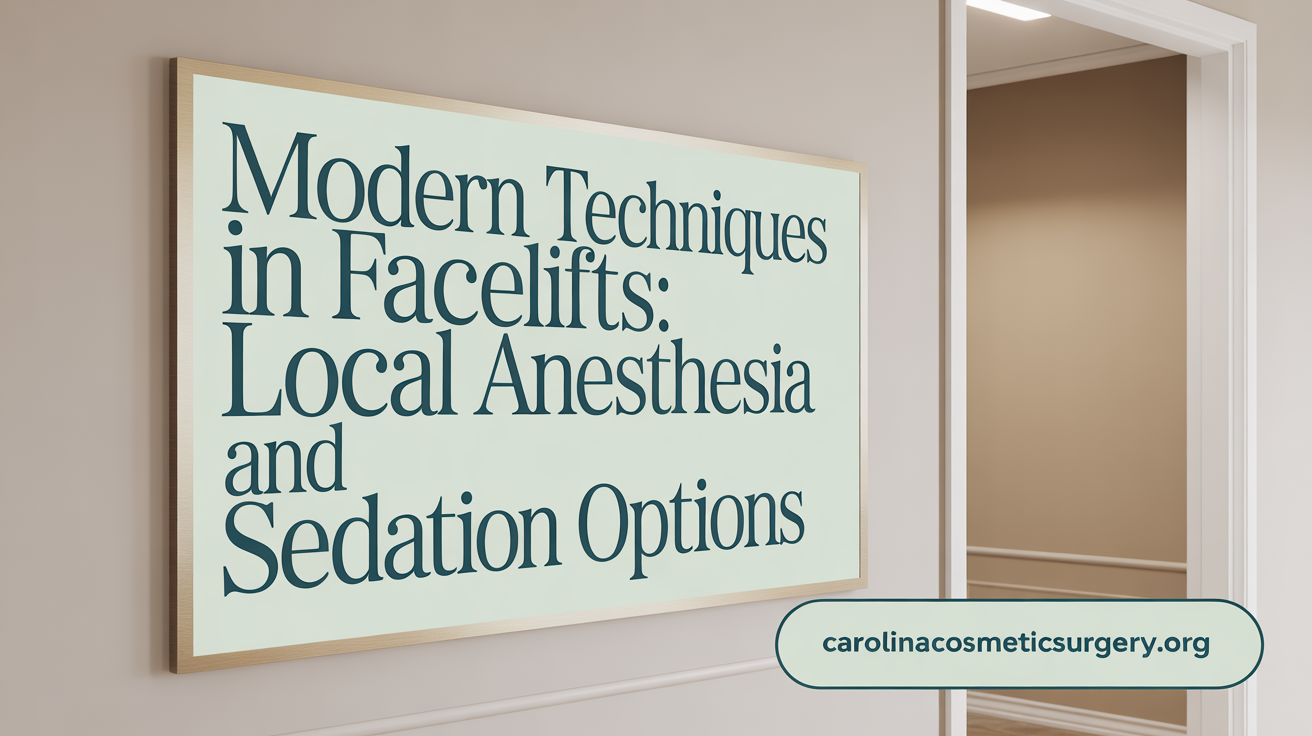Facelifts and Anesthesia: A New Paradigm
Facelift surgery has traditionally been associated with general anesthesia, often viewed as a necessary component for patient comfort and procedural safety. However, advances in surgical techniques and anesthesia have introduced alternatives that challenge this notion. This article explores the feasibility and advantages of performing facelifts without general anesthesia, examining various techniques, safety considerations, patient eligibility, recovery, and the evolving preferences in modern facial rejuvenation.
Understanding Facelifts Without General Anesthesia: Is It Feasible?

Is it possible to perform facelift procedures without general anesthesia?
Yes, many modern facelift procedures are now performed without the need for general anesthesia. Surgeons use local anesthesia, sometimes combined with IV sedation or twilight anesthesia, to keep patients comfortable and relaxed during surgery. This approach allows patients to remain awake yet numb, reducing risks associated with full unconsciousness.
Techniques used in awake and local anesthesia facelifts
Surgeons like Dr. Talei and others employ techniques such as the modified deep plane release and the Reflection Lift, which utilize local anesthesia injected into facial tissues. These methods enable precise tissue manipulation and repositioning while preserving patient safety.
Combination of local anesthesia with IV sedation or twilight anesthesia
Most awake facelifts involve a mix of local anesthesia for numbing, complemented by IV sedation or twilight anesthesia. These sedatives relax the patient further, making the experience even more comfortable without the risks of general anesthesia.
Patient experience during awake facelifts
Patients typically report feeling only pressure or fullness during the procedure. Afterward, some mild discomfort might be experienced, but pain medication is usually unnecessary. The benefit is less swelling, bruising, and quicker recovery, often allowing patients to resume normal activities within a week or two.
Examples of surgeons and signature techniques
Dr. Boggess has developed the Reflection Lift, a signature technique performed under local anesthesia, tailored to patient needs and levels of facial aging. The EVELift® procedure by Eden Plastic Surgery is another example, emphasizing safety, minimal trauma, and rapid recovery.
| Technique Name | Anesthesia Used | Main Benefit | Suitability |
|---|---|---|---|
| Reflection Lift | Local anesthesia with oral or IV sedation | Natural results, reduced risks | Most patients with mild to moderate aging |
| EVELift® | Local anesthesia or IV sedation | Quick recovery, minimal scarring | Lower face & neck rejuvenation |
| Mini Facelift | Local anesthesia, minimal invasiveness | Shorter recovery, effective for mild to moderate sagging |
Performing facelifts without general anesthesia is increasingly popular among experienced surgeons, offering a safer, faster, and less uncomfortable alternative for suitable candidates.
Techniques and Sedation Options for Awake Facelifts

What are the different techniques for performing facelifts under local or awake anesthesia?
Facelifts performed using local or awake anesthesia typically involve methods such as tumescent infiltration, where a solution of local anesthetic and vasoconstrictors is injected into facial tissues to numb the area and minimize bleeding. Surgeons may also employ nerve blocks to target specific facial nerve pathways, providing focused numbness.
Signature procedures like the EVELift® and Reflection Lift are designed to be minimally invasive, allowing for precise layer-by-layer dissection and tissue repositioning. These techniques often involve small incisions near the ears, with an emphasis on natural results and minimal scarring.
During the procedure, surgeons tighten and lift sagging skin, reposition facial fat, and remove excess tissue as needed. The use of local anesthesia and sedation allows for a more comfortable experience, with the patient remaining relaxed and awake, yet free of pain.
Advances in these methods include detailed preoperative planning and intraoperative monitoring, ensuring safety and optimal outcomes. These approaches aim to reduce trauma, bruising, and swelling while emphasizing a natural, youthful appearance.
What sedation options are commonly used during facelift surgeries that do not involve general anesthesia?
Sedation options for facelifts without general anesthesia include the administration of oral medications such as Valium or Halcion for relaxation. Many surgeons prefer IV sedation, often called twilight or conscious sedation, which involves administering sedatives through an IV line to induce a state of deep relaxation.
This form of sedation offers several benefits: the patient remains conscious but relaxed, with the ability to respond to commands, while the sensation of pain is blocked by local anesthetics. Patients usually experience a quicker recovery, less nausea, and minimal grogginess compared to general anesthesia.
In addition, twilight anesthesia enhances intraoperative monitoring of facial nerve function and allows the patient to be positioned upright for better access. Overall, these sedation techniques prioritize safety, comfort, and efficient recovery, making awake facelifts a popular choice among both patients and surgeons.
Safety, Risks, and Benefits of Facelifts Without General Anesthesia

What benefits and advantages does avoiding general anesthesia offer in facelift procedures?
Avoiding general anesthesia brings several significant benefits for patients undergoing facelift surgery. First, it reduces the risks associated with airway management, such as airway obstructions, and minimizes the chance of cardiovascular complications like blood pressure fluctuations and heart strain. Patients also experience less nausea and post-operative fatigue, which can facilitate a quicker recovery. Most patients can return to daily activities within one to two days after the procedure, making recovery less disruptive. Procedures performed under local anesthesia tend to be more cost-effective, as they do not require an anesthesiologist or the extensive resources typically involved with general anesthesia. Another advantage is the ability for surgeons to communicate with patients during surgery. This can help in making real-time adjustments and ensuring that natural results are achieved. Additionally, staying awake allows patients to have a better understanding of their procedure, increasing satisfaction.
What are the safety considerations and risks associated with awake, local, or sedation-based facelift procedures?
When performed by experienced surgeons, awake, local, or sedation-based facelifts have safety profiles comparable to traditional surgeries under general anesthesia. Risks like hematomas, infections, and nerve injuries are present but are generally manageable with appropriate surgical techniques and monitoring. Avoiding general anesthesia eliminates the risks related to airway management, such as breathing tube complications, and minimizes anesthesia-related side effects like grogginess, confusion, and nausea. These techniques also tend to result in less intraoperative bleeding, which improves visualization of tissues, and reduces postoperative swelling and bruising. Careful patient selection and vigilant intraoperative monitoring are essential to maintain safety.
How do facelift procedures under local or awake anesthesia compare to traditional facelifts performed under general anesthesia?
Facelifts done with local anesthesia, often combined with sedation, offer faster recovery times and fewer side effects compared to traditional methods under general anesthesia. Patients typically avoid the grogginess and cognitive disturbances that can follow general anesthesia, and they rarely need to fast before the procedure. The ability to remain awake and communicate during surgery allows for more precise tissue repositioning, ultimately resulting in more natural-looking results. While traditional general anesthesia remains necessary for extensive or complex surgeries, local and awake techniques are particularly advantageous for mild to moderate cases or patients seeking minimal downtime. This approach also often results in less postoperative discomfort, less swelling, and quicker return to normal activities, making it attractive for many patients.
Additional Information
| Aspect | Traditional Facelift | Awake Facelift (Local Anesthesia) | Benefits |
|---|---|---|---|
| Anesthesia type | General anesthesia | Local anesthesia with or without sedation | Safer, fewer complications |
| Recovery time | Up to 2-3 weeks | 1-2 weeks | Quicker return to activities |
| Risks | Airway complications, nausea, confusion | Minimal, mainly surgical risks | Reduced anesthesia-related risks |
| Patient awareness | Unconscious | Awake and comfortable | Enhanced communication, natural results |
| Postoperative discomfort | Generally more swelling and bruising | Less swelling and bruising | Quicker, more comfortable recovery |
| Cost | Higher due to anesthesia resources | Lower, no anesthesiologist needed | Cost-effective and safer for many |
Candidates suitable for awake facelifts are typically healthy individuals with mild to moderate aging signs. Patients with complex conditions or extensive aging may still require traditional approaches. In all cases, consultation with an experienced surgeon is essential to determine the most appropriate anesthesia method, considering individual health status and aesthetic goals.
Patient Eligibility and Recovery After Awake Facelifts
Who is eligible or suitable for facelifts performed without general anesthesia?
Ideal candidates for awake facelifts are generally healthy individuals with mild to moderate signs of facial aging. They often seek a less invasive approach with quicker recovery times and want to avoid the risks associated with general anesthesia. These patients usually have realistic expectations about the results and do not have significant contraindications to local anesthetic agents.
Patients considering multiple procedures, those with severe back problems, or significant medical conditions such as uncontrolled hypertension or diabetes might not be suitable for these techniques. It’s essential to have a thorough consultation with a skilled facial plastic surgeon to determine the best anesthesia approach based on individual health, surgical goals, and personal preferences.
What does the typical recovery process look like after awake or local anesthesia facelifts, and what tips aid recovery?
Recovery from awake facelifts typically involves less swelling and bruising compared to traditional methods. The peak of swelling and discoloration usually occurs within the first few days post-operation.
Most patients can expect to return to light activities and work within approximately 1 to 2 weeks. Stitches are generally removed around the end of the first week, and many feel comfortable resuming normal routines quickly.
To promote optimal healing, patients are advised to rest adequately, keep their head elevated to reduce swelling, and protect facial scars from sun exposure. Cold compresses are beneficial to minimize bruising, and following post-operative care instructions diligently enhances results.
Full recovery, including the resolution of swelling and scar maturation, can take several months. Most individuals experience minimal discomfort, and pain medication is rarely necessary. With proper care, patients often find that they can return almost fully to their daily lives shortly after surgery.
Addressing Common Questions and Concerns About Facelifts Without General Anesthesia
Many patients considering a facelift have questions about the procedure, especially when it is performed without general anesthesia. One of the most common concerns revolves around pain and comfort during the surgery. Patients worry whether local anesthesia and sedation can effectively numb the face and keep them comfortable throughout the operation. Surgeons use advanced techniques such as nerve blocks and tumescent fluids to ensure a pain-free experience, often complemented by IV sedation to promote relaxation.
Effectiveness is another important topic. Studies and clinical experience show that awake facelifts, performed using local anesthesia, yield results comparable to traditional methods involving general anesthesia. These procedures can tighten facial tissues, improve sagging, and produce natural, long-lasting outcomes.
When comparing results with traditional lifts, many patients and surgeons note less swelling, fewer hematomas, and quicker recovery times with awake approaches. The minimized trauma contributes to a more natural appearance and reduces complications.
Cost is a significant consideration for many. Awake facelifts often cost less because they do not require an anesthesiologist or the extensive resources associated with general anesthesia. This makes the procedure more accessible and affordable while maintaining safety and effectiveness.
Regarding frequently asked questions, patients seek reassurance about safety, recovery, and suitability. Most healthy individuals are good candidates, but those with specific medical conditions or those requiring extensive facial work might be advised to opt for traditional anesthesia. Surgeons recommend thorough consultation to discuss individual health, aesthetic goals, and preferences.
In summary, awake facelifts present a safe, effective, and cost-efficient alternative to traditional surgery, with many patients enjoying quicker recovery and more natural results. For more detailed information, prospective patients are encouraged to consult with experienced surgeons and review patient FAQs about awake facelift procedures.
Embracing Safe, Effective Facelifts Without General Anesthesia
Facelift procedures without general anesthesia have emerged as a safe and effective alternative for patients seeking facial rejuvenation with fewer risks, reduced recovery time, and natural-looking results. Advances in surgical technique and sedation have made awake facelifts increasingly accessible, offering benefits including cost savings and enhanced patient comfort. While not suitable for everyone, careful patient selection and consultation with experienced surgeons allow many to enjoy rejuvenation without the downtime and risks of general anesthesia. As awareness grows, this paradigm offers a modern, patient-friendly approach to aging gracefully.
References
- Beverly Hills Awake & Painless Facelift | Los Angeles
- Facelift without General Anesthesia: Top 3 Stunning Results
- Do I Need A General Anesthesia For My Facelift Or Neck Lift?
- Facelift Under Local Anesthesia
- Can a Facelift Be Performed With Local Anesthesia? (Updated 2024)
- The Benefits of a Mini Facelift - Duly Health and Care
- How to have a legit deep plane facelift under local anesthesia and ...
- Best Awake Facelift in New York City | Mansher Singh, MD
- Awake Facelifts: What You Need to Know - Westlake Dermatology
- Facelift and Neck Lift Under Local Anesthesia
